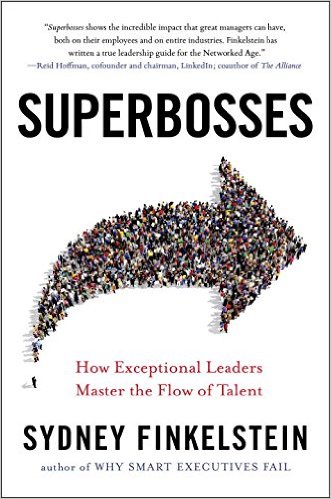Finkelstein is one of the big names in management/leadership circles. He’s the director of Tuck’s Center for Leadership at Dartmouth College, and a consultant and speaker to senior executives around the globe. So when he speaks (or writes), it’s wise to pay attention. This latest book is the counter to Why Smart Executives Fail. Instead of examining bad behaviors, it looks at positive ones. And it’s an interesting read.
Superbosses, by definition, are better than run-of-the-mill good managers because they unleash unprecedented creativity, engagement, and accomplishment in their teams, generating and regenerating great talent. Here are the five traits of superbosses, based on Finkelstein’s research: all possess extreme confidence, even fearlessness, when it comes to furthering their agendas and ideas. They are all extremely competitive. They are visionaries. They manifest integrity: strict adherence to a core vision or sense of self. And, finally, they are authentic.
Finkelstein divides Superbosses into three groups. The “Iconoclasts” are so wholly fixated on their vision that they are able to teach in an intuitive, organic way, as a natural outgrowth of their passion and in service to it, rather than consciously or methodically. These are the artists among the superbosses, the ones we think of as creative geniuses. The author includes Miles Davis, Alice Waters, George Lucas, Lorne Michaels, and Ralph Lauren among this group.
Then there are the “Glorious Bastards,” superbosses less attuned to developing others than they are to winning, no matter what. They understand that in order to win, they need the best people and the best teams. They may be egoists, they may want fame and glory, but they perceive the success of those around them as the pathway to that glory. As a result, they teach people how to win, inspire them with examples of what winning feels like, and push them to ever higher levels of performance. He includes Larry Ellison, Michael Milken, Roger Corman, and Bonnie Fuller among this group.
Finally, there is the benevolent “Nurturer” superboss. They are constantly present to guide and teach their protégés, and they actively engage with employees to help them reach great heights. This group includes Bill Walsh, Mary Kay Ash, Gregg Popovich, Jon Stewart, and Archie Norman.
Intuitively, one would think that the Nurturers would be the most successful, but Finkelstein disputes this thought. His research indicates that all three types of superbosses are extraordinary at spawning talent, and that’s ultimately what counts.
In the book, Finkelstein develops what he calls the “Superboss Playbook,” which discusses each aspect of superboss behavior and offers suggestions for how regular bosses can incorporate some of these behaviors into their management style. It’s a fun read, and you will probably find at least two or three things that you can do to inspire talent to reach greater heights. For example, the chapter on networking for success was one of my favorites. He says to not be afraid of attrition, but consider it inevitable. When employees leave, “be smart: act like a concerned godparent and stay in touch with them.” Ensure that succession plans are in place for all top jobs, and when employees leave, do your best to sustain the bonds that were built while your former employees were still with you. You don’t know how or when opportunities will come up to work together again.
At the end of the book is a list of questions to see if you manage like a superboss. Some of these are: Do you have a specific vision for your work that energizes you, and that you use to energize and inspire your team? How much affection or connection do members of your team feel with one another? What is the balance of competition and collaboration on the team? Do you continue to stay in touch with employees who have left to work elsewhere?
He ends by telling readers not to fall into the trap of thinking that becoming a superboss is impossible. It’s not. Yes, the superbosses profiled in this book are extraordinary people—forces of nature—but there’s no reason any of us can’t become at least a little bit more like them.
While reading this book, I found myself thinking more creatively and on a larger scale about my job and my life, and I kept coming up with new ideas and ways to impact the world in a small way. Even if you don’t want to become a superboss, this book will stimulate your thinking and give you some good ideas. I promise.

